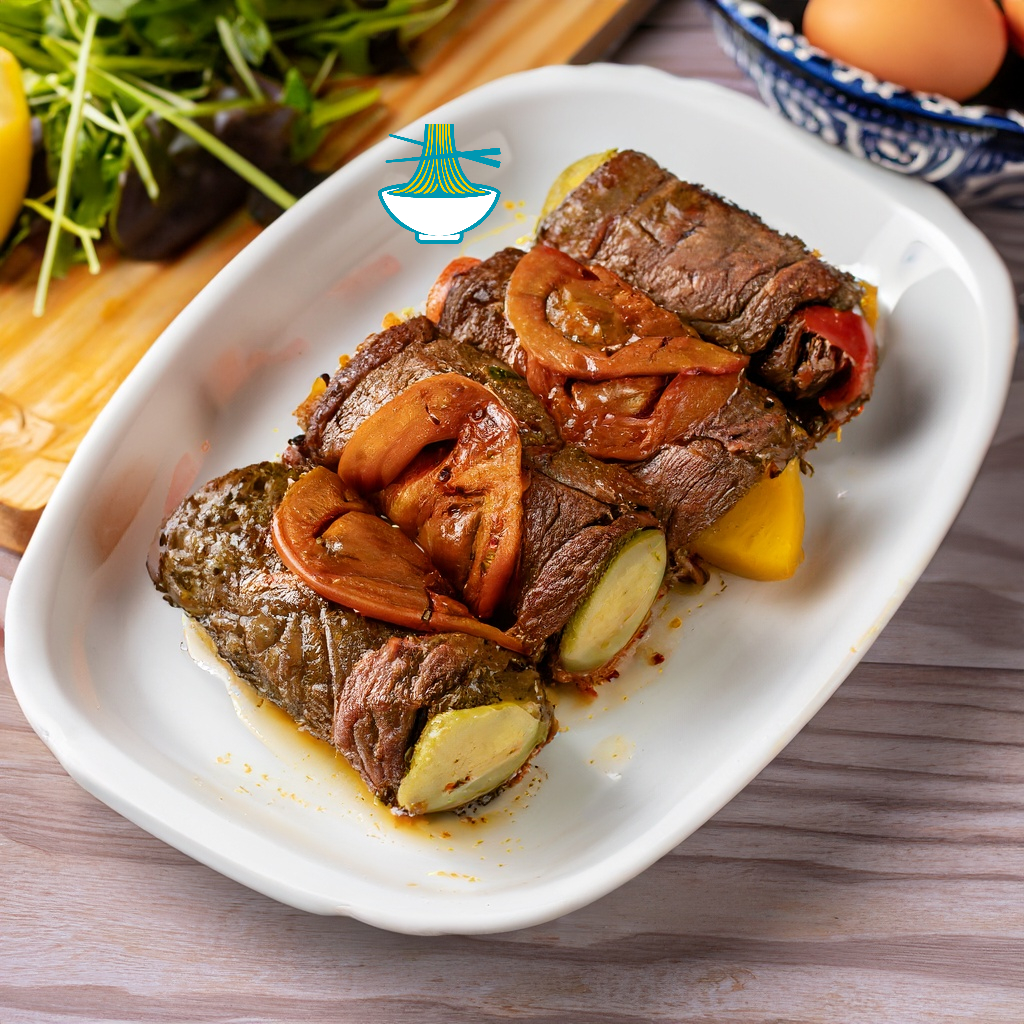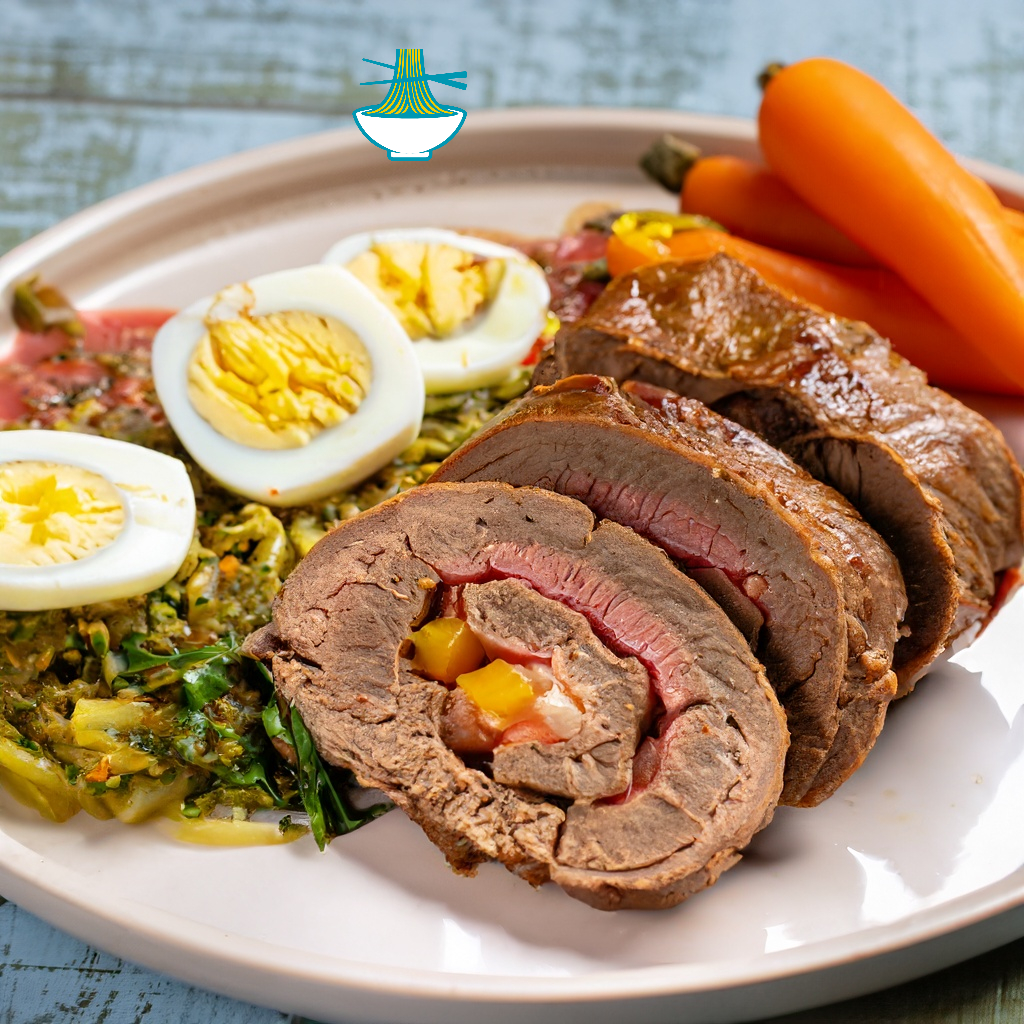Matambre Arrollado is a traditional Argentine dish known for its flavorful combination of beef, steak, vegetables, herbs, and hard-boiled eggs. Often referred to as the "hunger killer" due to its filling nature, this dish is typically enjoyed during special occasions like Christmas, Easter, or family gatherings. The recipe involves stuffing a thin layer of meat with ingredients like carrots, bell peppers, onions, and garlic, then rolling and cooking it until tender. Aside from being delicious, Matambre Arrollado offers various nutritional benefits, such as providing a good source of protein, vitamins, and minerals. The beef offers essential nutrients like iron and zinc, which support immune function and muscle health. However, as with any rich dish, it should be consumed in moderation, especially for those watching their cholesterol levels. Additionally, the versatility of this dish allows for adaptations, catering to various dietary preferences like gluten-free or vegetarian versions. Whether served as an appetizer or main course, Matambre Arrollado is a perfect blend of tradition, flavor, and nourishment.

Ingredients:
1- 1 beef flank steak, about 1-1.5 kg
2- 2 carrots, peeled and sliced
3- 2 red bell peppers, seeded and sliced
4- 2 hard-boiled eggs, sliced
5- 2 cloves of garlic, minced
6- 1 onion, chopped
7- 1/2 cup of chopped parsley
8- Salt and pepper to taste
9- 1 tablespoon of olive oil
10- 2 cups of beef broth
Method:
1- Preheat the oven to 350°F (180°C).
2- Lay the beef flank steak flat on a cutting board and use a meat tenderizer to pound it evenly to a thickness of about 1/2 inch.
3- Season the steak with salt and pepper on both sides.
4- Spread the sliced carrots, red bell peppers, garlic, onion, and parsley evenly over the surface of the steak, leaving a border of about 1 inch around the edges.
5- Arrange the sliced hard-boiled eggs on top of the vegetables.
6- Starting from one of the long edges, roll the steak up tightly into a cylinder, tucking the edges in as you go.
7- Tie the rolled-up steak with kitchen twine at intervals of about 2 inches to hold its shape.
8- In a large oven-safe pot or Dutch oven, heat the olive oil over medium-high heat.
9- Add the rolled-up steak to the pot and brown it on all sides, about 5 minutes per side.
10- Pour the beef broth into the pot, cover with a lid, and transfer to the preheated oven.
11- Bake for about 2-2.5 hours, or until the meat is tender and the internal temperature reaches 160°F (71°C).
12- Remove the pot from the oven and let the matambre arrollado cool to room temperature.
13- Remove the twine and slice the matambre arrollado into thin rounds.
Additional suggestions:
- You can add other vegetables such as zucchini or spinach, or even incorporate olives, raisins, or bacon for extra flavor.
- Using herbs such as parsley or thyme can enhance the taste and make the dish more flavorful.
Note:
- You can customize the filling of the matambre arrollado according to your preferences. Some traditional variations include using hard-boiled eggs, olives, and raisins, or adding spinach, cheese, and bacon.
- Consuming too much of this dish may lead to increased cholesterol levels due to its saturated fat content. People with heart conditions or those watching their cholesterol intake should enjoy Matambre Arrollado in moderation or opt for leaner meat alternatives.
Frequently asked questions:
What is the nutritional value of Matambre Arrollado?
- Matambre Arrollado is rich in protein, vitamins (such as A and C), and minerals (such as iron and zinc). The beef provides a good amount of protein, while the vegetables offer vitamins and fiber. The dish is also relatively high in fat due to the beef, but it can be adapted to suit different dietary preferences.
Can Matambre Arrollado be prepared in a healthier way?
- Yes, Matambre Arrollado can be prepared in a healthier way by using leaner cuts of meat, such as chicken breast instead of beef. You can also reduce the fat content by using olive oil instead of other cooking oils and choosing low-sodium or no-salt added ingredients for the filling. Additionally, adding more vegetables to the filling increases the dish's fiber and vitamin content.
Can Matambre Arrollado be adapted for specific dietary needs?
- Yes, this dish is highly adaptable. For individuals with gluten intolerance, you can use gluten-free breadcrumbs in the filling. For vegetarians or vegans, replacing the meat with tofu, seitan, or beans works as a great alternative. You can also omit eggs for those avoiding animal products.
Can Matambre Arrollado Be Frozen?
- Matambre Arrollado can indeed be frozen for later consumption. After preparing and cooking the dish, allow it to cool completely before wrapping it tightly in plastic wrap or aluminum foil. This will help preserve its freshness and prevent freezer burn. It can be stored in the freezer for up to 3 months. When ready to serve, simply thaw it in the refrigerator overnight and reheat it in the oven until it is heated through.
Varied Ways to Prepare Matambre Arrollado
- Matambre Arrollado is a versatile dish that can be adapted based on personal preferences or dietary needs. While the traditional recipe includes beef, variations of the dish can be made using different meats such as chicken or pork. Vegetarians can also make a plant-based version by replacing the meat with tofu or seitan, offering a protein-rich alternative.
Nutrition Facts:
1. Beef Flank Steak (1-1.5 kg)
- Calories: 1500 - 2250 kcal
- Carbohydrates: 0g
- Protein: 150g - 225g
- Fat: 75g - 112.5g
- Sodium: 200 - 300 mg
- Cholesterol: 300 - 450 mg
- Vitamins: B12, B6, niacin, riboflavin
- Minerals: Iron, zinc, phosphorus
- Nutritional Benefits:
- High-quality protein essential for muscle growth and repair.
- Rich in heme iron, supporting red blood cell production.
- Provides B vitamins for energy and nerve health.
- Zinc helps with immune function and wound healing.
2. Carrots (2 medium-sized)
- Calories: 50 kcal
- Carbohydrates: 12g
- Protein: 1g
- Fat: 0.3g
- Sodium: 60 mg
- Cholesterol: 0 mg
- Vitamins: Vitamin A, Vitamin C, Vitamin K
- Minerals: Potassium, calcium
- Nutritional Benefits:
- High in beta-carotene for eye health and vision.
- Promotes digestive health due to fiber content.
- Contains antioxidants to protect cells and support immune function.
3. Red Bell Peppers (2 medium-sized)
- Calories: 60 kcal
- Carbohydrates: 15g
- Protein: 2g
- Fat: 0.5g
- Sodium: 4 mg
- Cholesterol: 0 mg
- Vitamins: Vitamin C, Vitamin A, Vitamin B6
- Minerals: Potassium, magnesium
- Nutritional Benefits:
- High in Vitamin C, boosting immune function and promoting skin health.
- Contains antioxidants, including beta-carotene, to protect cells.
- Helps digestion and supports a healthy gut with fiber.
4. Hard-Boiled Eggs (2 large)
- Calories: 140 kcal
- Carbohydrates: 1g
- Protein: 12g
- Fat: 10g
- Sodium: 140 mg
- Cholesterol: 370 mg
- Vitamins: Vitamin D, Vitamin B12, Vitamin A
- Minerals: Selenium, iodine, phosphorus
- Nutritional Benefits:
- High-quality protein for muscle building and repair.
- Contains choline for brain health and cell membrane function.
- Provides selenium as an antioxidant and supports immune health.
5. Garlic (2 cloves)
- Calories: 10 kcal
- Carbohydrates: 2g
- Protein: 0.5g
- Fat: 0g
- Sodium: 1 mg
- Cholesterol: 0 mg
- Vitamins: Vitamin C, Vitamin B6
- Minerals: Manganese, calcium
- Nutritional Benefits:
- Contains allicin, which provides antibacterial, antiviral, and anti-inflammatory properties.
- Helps lower blood pressure and cholesterol levels.
- Packed with antioxidants that support the immune system.
6. Onion (1 medium-sized)
- Calories: 40 kcal
- Carbohydrates: 9g
- Protein: 1g
- Fat: 0g
- Sodium: 4 mg
- Cholesterol: 0 mg
- Vitamins: Vitamin C, Vitamin B6
- Minerals: Potassium, calcium
- Nutritional Benefits:
- Rich in antioxidants, especially quercetin, which has anti-inflammatory benefits.
- Supports digestive health with fiber content.
- Contains antimicrobial properties for immune support.
7. Parsley (1/2 cup, chopped)
- Calories: 10 kcal
- Carbohydrates: 2g
- Protein: 0.5g
- Fat: 0g
- Sodium: 1 mg
- Cholesterol: 0 mg
- Vitamins: Vitamin K, Vitamin C, Vitamin A
- Minerals: Iron, calcium, magnesium
- Nutritional Benefits:
- High in Vitamin K, important for blood clotting and bone health.
- Contains antioxidants to reduce oxidative stress.
- Acts as a natural diuretic, improving digestion.
8. Salt and Pepper (to taste)
- Calories: Negligible
- Carbohydrates: Negligible
- Protein: Negligible
- Fat: Negligible
- Sodium: Varies based on amount used
- Cholesterol: 0 mg
- Vitamins: None
- Minerals: Sodium (from salt)
- Nutritional Benefits:
- Salt provides sodium, which is essential for fluid balance but should be used in moderation.
- Pepper contains antioxidants that may support digestion and offer anti-inflammatory effects.
9. Olive Oil (1 tablespoon)
- Calories: 120 kcal
- Carbohydrates: 0g
- Protein: 0g
- Fat: 14g
- Sodium: 0 mg
- Cholesterol: 0 mg
- Vitamins: Vitamin E, Vitamin K
- Minerals: Iron
- Nutritional Benefits:
- Rich in heart-healthy monounsaturated fats.
- Contains polyphenols as antioxidants to protect the body from oxidative stress.
- Supports skin health and immune function with Vitamin E.
10. Beef Broth (2 cups)
- Calories: 30 kcal (assuming low-calorie broth)
- Carbohydrates: 4g
- Protein: 2g
- Fat: 0g
- Sodium: 500 - 700 mg (depending on the brand)
- Cholesterol: 0 mg
- Vitamins: Vitamin A, Vitamin C
- Minerals: Calcium, magnesium, potassium
- Nutritional Benefits:
- Contains collagen, supporting joint health, skin elasticity, and gut health.
- Offers essential minerals like calcium and magnesium for bone health.
- Contributes to hydration and provides savory flavors for cooking.
These nutritional values are approximate and may vary depending on the specific ingredients used.


Comments